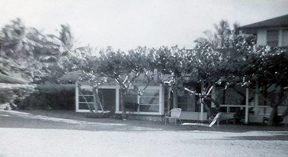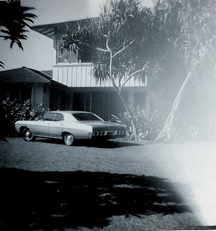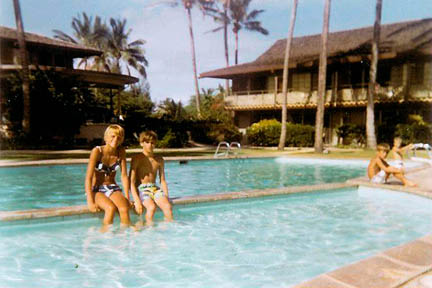


It could be a new beginning . . .
if Drew could only leave the past behind.

|
Don’t Look Back Young Adult Fiction A Weekly Reader Book Club |
A summer in Hawaii sounds like a vacation to die for: golden beaches, blue water, and devastatingly handsome surfers decorate the landscape. So why does Drew feel as if she’s dying from an anxiety attack before she even gets off the plane? It all has to do with her father. Two year ago he left home and moved to Kauai – without Drew or her mother – and Drew has never forgiven him. Now she must spend three long months with him, and his ‘friend’ Jane, wondering if a summer in paradise will help her figure out something about relationships and what makes them go wrong…or right. |
|
 |
 |
 |
“Drew has been afraid of flying, heights and romantic relationships ever since her doctor father walked out on her family to start a new life in Hawaii. The unhappy girl must face her phobias when she spends the summer with the man she has grown to despise. A fast-blooming relationship with a sensitive, good-looking surfer, however, helps Drew come to terms with both her fears and her anger. Wardlaw once again combines coming-of-age struggles with…a pleasing romance… [and] introduces a hint of substance to a genre that can be all too fluffy.” – Publisher’s Weekly “…the novel [has offered] support to many of my adolescent clients who can identify with anger at the absent parent, the feelings of abandonment when divorce occurs, the ambivalence about accepting a new stepparent; and the list go on…” – Joyce M. Lunt, Ph.D. |
 |
 |
 |

The Story Behind the Story:
How old were you when you started writing Don't Look Back? I had just turned 30. How long did it take to write it? About five or six months to create a draft I was proud of, one I thought was ready for my agent to start submitting to publishers. Of course, ‘submitting’ is not synonymous with ‘accepting’. At least 15 editors rejected the book, and each time that happened, I’d revise…and revise…and revise. So, it probably took me close to a year to turn the story into the one you can read today. How long did it take before Don’t Look Back was published? Seven. Long. Years. I finished writing the novel in June of 1986; it was published in the fall of 1993. Originally, it was supposed to be released in 1990, but the editor and I had a major disagreement and I, er… canceled the contract. Believe me: that was one of the hardest decisions I've ever made! Not only did I have to give back the advance money – which, ahem, I'd already spent – I took the risk that my book would never be read by anyone other than my husband and our cats. I mean, the manuscript had already been rejected by just about every major publishing house – some of them twice! My editor at Avon/Flare (the young adult paperback division of William Morrow, now HarperCollins) had actually rejected the manuscript thrice. But, Corey’s Fire had done well for them, and when I begged my editor to take one last (fourth!) peek at Don’t Look Back, she sighed but agreed…and ultimately offered a contract. Whew! What was the disagreement you and the first editor had? An editor’s job is to read a manuscript carefully, objectively, and offer suggestions on how the author can make the book stronger, better, best. In my case, however, the editor didn’t just suggest, she made major changes to the book herself without my permission. That’s a major no-no. Worse, her revisions changed the tone, style and voice of my characters – making them corny, homogenized – to the point where I didn’t want my name on the book. We couldn’t come to a compromise, so I gulped and canceled the contract. Were any of the characters based on anyone you know? Drew, the main character, has elements of me, just as all my protagonists do. For example, my parents divorced when I was 12, so I know first-hand how that feels; and I have two younger brothers, so I’ve experienced that older-sister-mothering stuff that Drew exhibits. Otherwise, Drew’s situation and experiences and characteristics are all her own. Patsy, aka Sunglasses, is a combination of several guys I knew in Hawaii when I was in my 20’s. Kristin, with her exuberant sense of adventure, is whom I’d like to be when I grow up!
What made you decide to have Hawaii as the setting? Kauai is my favorite of all the Hawaiian islands. My family first stayed there for a summer vacation when I was almost 13. We rented an old beach house on the rocky point between Poipu Beach Park and the original Waiohai Hotel. Best. Vacation. Ever. I learned how to surf, hula and make leis. We’ve traveled to Kauai almost every summer since. I consider the island my second home. It’s also an incredibly romantic place: awesome sunsets, swaying palm trees, frothy surf, golden beaches to walk along with the Person of Your Dreams ...
A postcard of the old Waiohai Resort, mid 1960’s
Are the towns, beaches and neighborhoods you mentioned in the book real? All of them are real, although I changed the name of one: Kapakai Resort, where Sunglasses works, is based on the Kiahuna Plantation Resort, my family’s favorite place to stay since 1981. The neighborhood where Drew’s father and Jane live is near Brennecke’s Beach, where I bodysurfed as a kid. (It’s a dangerous place – ultra-rocky – to body surf today, after being almost decimated in hurricane Iniki in 1992.) My brother owns a condo in that neighborhood today, across the street from Drew’s dad’s house.
|
|
 |
 |
Kiahuna Plantation Resort
Poipu Beach, Kauai
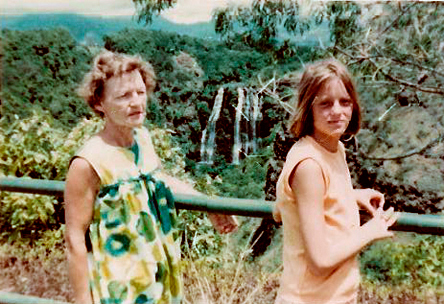
My grandma and me,
being grumpy (hey, I was almost 13!
Isn’t that what 13-year-olds are?)
at 'Opeaka'a Falls
Bodysurfing at Brennecke’s Beach |
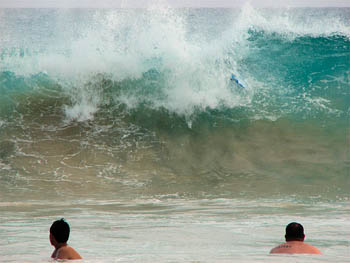 |
Which character was easiest for you to write for? Which was the most difficult? Kristin was definitely the easiest! She was so enthusiastic and exuberant and fun that her personality practically wrote itself. Drew was the hardest because I had to walk a jagged edge between her anger, her bitterness and the cool parts of her personality that had been submerged and were just starting to resurface. Too much bitterness and readers might’ve found her unappealing; too little, and the story might’ve lacked conflict and authenticity. Hence: rewrite and rewrite after rewrite! I knew I’d nailed her character, though, when a local therapist, who specialized in working with teens, offered to write a blurb for the book. She said I handled all the psychological bits of Drew perfectly. Judging from my fan letters, my readers agree! Do you have a favorite character, or do you not like to play favorites? This is a hard question to answer. I become so involved in creating my characters, living with them for months as I write, that they become real people to me, almost like my children! And, of course, it’s hard to play favorites when you’re talking about your own kids. But, if I have to choose a fav from this book, it would be Patsy. I have a huge, mad, delicious crush on him! He’s soooo gorgeous. And intelligent. And funny. And… Sigh. I’m also enamored with Kristin. She’s SO fun. I liked her so much that I ended up giving her the starring role in the next YA novel I wrote: Tease for Two. Unfortunately, that novel has never been accepted for publication. Were any parts of the story difficult for you to write? Yup. The scene where Drew finally unleashes her anger at, and her love for, her father was especially tough. It turned out hugely melodramatic the first few times around. So I spent a lot of time paring, distilling the words, the emotions, the pages to create a raw yet believably dramatic climax. What was the creative process you used to create the characters? I use the same process for every protagonist in every book I write. First, I ask myself seven crucial questions:
In other words, I need to know the main character’s motivations: the values, needs and desires that drive her to action. To get to that psychological, emotional and intellectual core, I dig deeply into her personality and environment by answering – in her own voice – about 50 questions I’ve created to flesh her out. Usually, I end up with answers that fill ten, twenty, thirty pages or more, typed, single-spaced! To create the supporting characters, I answer similar questions, although I don’t dig quite as deep into their psyches unless the plot or conflict warrants it. What are some of the questions you ask? Things like: What makes this character laugh? Who are her best friends (or ex-friends) – and why? What makes her angry – and how does she express that anger? What is her most embarrassing moment? Her most heartbreaking? Most frightening? How did she deal with those situations? What does she like to read? Eat? Who are her parents and siblings, and what kind of relationship does she have with them? What is her clothing style, and what does this say about her? ETC. How is writing a book aimed at teenagers/young adults different from writing one for children/preteens? What did you have to keep in mind?
All good books – whether written for children or adults – have the same essential elements:
Here are a few things you need to keep in mind, though, when writing teen books versus books for children:
Nope! Corey’s Fire has been called a ‘romance’ by some reviewers. (There’s a romance in it, although that’s not the driving force behind the protagonist.) But my first true YA romance novel was Alley Cat, published in 1987 by Silhouette, Harlequin’s teen imprint. Actually, I don’t consider Alley Cat or Don’t Look Back ‘romances’. To me, Don't Look Back is more a story about Drew dealing with her resentment and anger and hurt at being abandoned by her father, as opposed to experiencing her first love. (Although the former has repercussions felt in the latter.) What was the first romantic story you ever wrote? (Yes, short little drabbles written when you were much, much younger count!) In junior high, I wrote a lot of poetry that oozed teen romance angst. Sappy, wretched stuff. Lots of woe-is-me, unrequited love. But I didn’t write an actual story with a romantic-theme until I was 24. (No, it was never published.) Why did you decide to end the story on somewhat of a loose end? I didn’t know I did! But if it’s true, I probably did it unconsciously, knowing that my teen readers would be intelligent enough to fit the puzzle pieces together . . . Was Don’t Look Back your original title? No! I titled the original manuscript To Walk a Jagged Edge Don’t Look Back is currently out of print. However, if you would like to purchase an autographed copy in hardcover or paperback, please email Lee by clicking on the Contact Me icon.
Teen Links Are you a teen whose parents are separating or divorced? Then check out these sites:
Aloha LinksPoipu Shores Vacation Rental (My brother's condo!)
If you would like to order a personally-autographed copy of this title, please write to Lee by clicking on the Contact Me icon.
|
|



